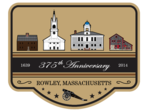Agawam Diner
Buildings and structures in Rowley, MassachusettsCommercial buildings completed in 1954Diners in MassachusettsDiners on the National Register of Historic PlacesNational Register of Historic Places in Essex County, Massachusetts ... and 4 more
Restaurants established in 1940Restaurants on the National Register of Historic Places in MassachusettsTourist attractions in Essex County, MassachusettsU.S. Route 1

The Agawam Diner is an historic diner at 166 Newburyport Turnpike (U.S. Route 1) in Rowley, Massachusetts. It was manufactured in 1954 and moved to this location in 1970 after first being in Ipswich. It is the town's only diner and one of only six in the state manufactured by the Fodero Dining Car Company. It was listed on the National Register of Historic Places in 1999.
Excerpt from the Wikipedia article Agawam Diner (License: CC BY-SA 3.0, Authors, Images).Agawam Diner
Haverhill Street,
Geographical coordinates (GPS) Address Nearby Places Show on map
Geographical coordinates (GPS)
| Latitude | Longitude |
|---|---|
| N 42.704722222222 ° | E -70.910277777778 ° |
Address
Haverhill Street 406
01969
Massachusetts, United States
Open on Google Maps











